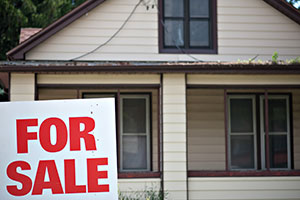Purchases of Previously Owned Homes Rebounded in March

Purchases of previously owned U.S. homes rose more than projected in March, indicating resilience in demand heading into the spring selling season.
Contract closings climbed 5.1% to a 5.33 million annualized rate from February’s 5.07 million, figures from the National Association of Realtors showed April 18 in Washington. The median forecast of 75 economists in a Bloomberg News survey called for a rise to 5.28 million. Prices rose as inventories remained tight.
The report underscores the role that strong hiring and low borrowing costs are playing in supporting housing at a time the economy is restrained by fragile manufacturing and weak global markets. Faster wage growth and more participation from first-time homebuyers would help usher further gains in sales.
“Conditions are more positive for buyers now that mortgage rates have dipped back down,” said Robert Dye, chief economist at Comerica Inc. in Dallas, who correctly projected the gain in sales. “Jobs have been a key support.
Hopefully, we are starting to pull some of the marginal buyers back into the housing market.”
Bloomberg survey estimates for previously owned home sales ranged from 5.07 million to 5.50 million in March. The prior month’s pace was revised from 5.08 million.
Compared with a year earlier, existing-house purchases increased 1.5% in seasonally adjusted data.
The median price of an existing home rose 5.7% from March 2015 to reach $222,700.
While rising property values allow homeowners to feel wealthier and make it easier for them to sell their dwellings, the price gains limit affordability for prospective buyers.
There were 1.98 million houses on the market at the end of March, down 1.5% from the same month last year, the April 20 report showed.
At the current sales pace, it would take 4.5 months to sell those houses compared with 4.4 months at the end of the prior month. Less than a five months’ supply is considered a tight market, the Realtors group has said.
The median time a home was on the market decreased to 47 days from 52 days a year earlier.
Sales of existing single-family homes increased 5.5% to an annual rate of 4.76 million. Purchases of multifamily properties — including condominiums and townhouses — climbed 1.8% to a 570,000 pace.
Purchases climbed in all four regions led by an 11.1% jump in the Northeast.
First-time buyers accounted for 30% of all purchases, which remains a historically low share, according to Lawrence Yun, NAR chief economist. “Homes sales are very steady with some volatility,” Yun said in a news conference as the report was released.
The gain in demand is being paced mostly by sales of middle-market houses in the $100,000 to $500,000 range, Yun said. The lower end of the market is being hurt by a “tremendous shortage of inventory,” he said. Additionally, the turmoil in stocks at the start of the year probably weighed on demand for houses priced at $1 million or more, according to Yun.
Recent reports indicate some weak spots in the industry. New-home construction slumped more than projected in March, reflecting a broad-base retreat, Commerce Department figures showed April 19. Housing starts fell 8.8% to a 1.09 million annualized rate that was the lowest since October. Permits, a proxy for future construction, also unexpectedly dropped.
Prospective buyers continue to benefit from relatively low borrowing costs and Federal Reserve policy makers, who in December lifted interest rates for the first time since 2006, have said further moves will be gradual. The average rate for a 30-year fixed mortgage was 3.58% last week, the lowest since May 2013, according to data from Freddie Mac.
The job market is supporting home sales. The economy added 215,000 workers to payrolls in March after a 245,000 advance in February. The jobless rate of 5% is hovering near an eight-year low. Wage gains, though, are stuck in the 2% to 2.5% range since the expansion began in mid-2009.
Existing home sales, tabulated when a purchase contract closes, account for more than 90% of the residential market. New-home purchases, which make up the rest and are tabulated when contracts get signed, are considered a timelier barometer.


